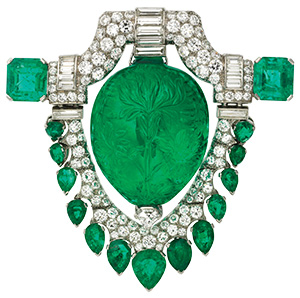|
Legacy
Masters of the Jewel
A new book chronicles the history of Oscar Heyman & Brothers, a firm that has been manufacturing fine jewelry since 1912.
By Phyllis Schiller
 |
| Diamond, emerald and platinum brooch circa late 1920s by Oscar Heyman & Brothers for Marcus & Co., formerly owned by Marjorie Merriweather Post. Photo courtesy Museum of Fine Arts, Boston. |
“I thought it was about time somebody looked at jewelry beyond the hallmark and took into consideration the manufacturing expertise that created the designs,” says Yvonne J. Markowitz, the Rita J. Kaplan and Susan B. Kaplan Curator Emerita of Jewelry at the Museum of Fine Arts, Boston (MFA), and author of the new MFA publication, Oscar Heyman: The Jewelers’ Jeweler. Throughout its history, the firm has created jewels for some of the biggest jewelry houses, Markowitz notes, calling Oscar Heyman the “unsung masters” when it came to manufacturing jewelers, and “certainly the most significant in the U.S.” The copiously illustrated book, which debuted in April, was co-authored with Elizabeth Hamilton, an independent writer and researcher.
The book puts the firm’s many standout creations into a design perspective. It covers the firm’s history from the apprenticeship of founding brothers Oscar and Nathan at a workshop in Eastern Europe that produced high-style ornaments for the Russian court jeweler Peter Carl Fabergé to their arrival in New York City in 1906, to the start of their own business and the jewels they created for their many illustrious clients.
“I think I could go through every decade and find really exceptional pieces made by Oscar Heyman,” Markowitz says. And while the majority of the jewelry the firm produced bears only the name of the client they made it for, there are, nonetheless, consistent hallmarks of their work, she points out. “It’s the quality of the materials they used.” It’s also the exquisite craftsmanship, some of which was cutting edge based on techniques the brothers patented. “Oscar and Nathan were always thinking ahead on how, from an engineering point of view, they could make their pieces more beautiful and also wearable.” For instance, their patents gave their link bracelets singular flexibility, says Markowitz. “If you flex it, an Oscar Heyman bracelet is almost like a textile in your hands. These are pieces that are beautifully executed as well as visually attractive.”
While to a certain extent, Oscar Heyman followed what the big houses wanted them to produce, says Markowitz, there were designs along the way that were notably theirs, like the Ballerina Ring, designed by George Heyman, which was popular from the late 1950s to the early 1980s. The through-line in their work, says Markowitz, is a “classic and timeless look.”
Some of the Oscar Heyman looks that have caught the attention of notable jewelry fans star incredible gemstones. According to Markowitz, the stones they used — ranging from emeralds and colored sapphires to opals, aquamarines, citrines and amethysts — was something that really set them apart.
One stellar example, shown on the cover of the book, is a magnificent diamond and emerald brooch that once belonged to heiress and famed jewelry collector Marjorie Merriweather Post, which is now owned by the MFA. “It’s an amazing piece when you handle it,” observes Markowitz. “The emerald is just gorgeous and is carved on both sides. Dating from the late 1920s, it combines elements of both the Edwardian era and Art Deco period, but, recalls Markowitz, the Oscar Heyman pedigree was not immediately discernible. The piece was attributed only to Marcus & Co. but she found a drawing of the brooch in the Oscar Heyman archives. “I think there probably are Oscar Heyman pieces in other collections, but people just don’t know it. For instance, a lot of people think the Taylor-Burton diamond necklace is a Cartier piece because Cartier sold it to the Burtons, but both the mounting and the manufacture were by Oscar Heyman,” points out Markowitz.
The company’s reputation has emerged in its own right, says Markowitz. “For the past 15 years, auction houses, when they can verify it, are very happy to mention that, say, the Van Cleef & Arpels Mystery Setting bracelet being offered was manufactured by Oscar Heyman. And it actually increases the value. The firm’s name has its own cachet and that’s because it’s synonymous with good materials and great craftsmanship.”
According to Tom Heyman, third-generation partner at Oscar Heyman, a common theme of the firm’s jewelry has been to showcase spectacular gemstones. The guiding design principle was “to create the finest piece of jewelry possible, and to always go a little bigger rather than a little smaller in order to achieve that. If we have a 4-carat center stone, we’re not going to use 30-point side stones, we’re going to use carat side stones.” And he notes, while the company is still a wholesale business, relying on strong retail partnerships throughout the country, it is working to expand brand awareness. “If a jewelry sales associate is showing customers one of our pieces, we want them to know it is Oscar Heyman, and we want them to know what that means about the quality and integrity of the jewelry.”
“Sometimes when I work on a project,” sums up Markowitz, “I don’t come away with as lofty an opinion as I started out with, but that was the opposite case with me here. I came away a lot more respectful and that was a nice ending for me. I think part of it has to do with the integrity of the firm through today.”Article from the Rapaport Magazine - May 2017. To subscribe click here.
|
|